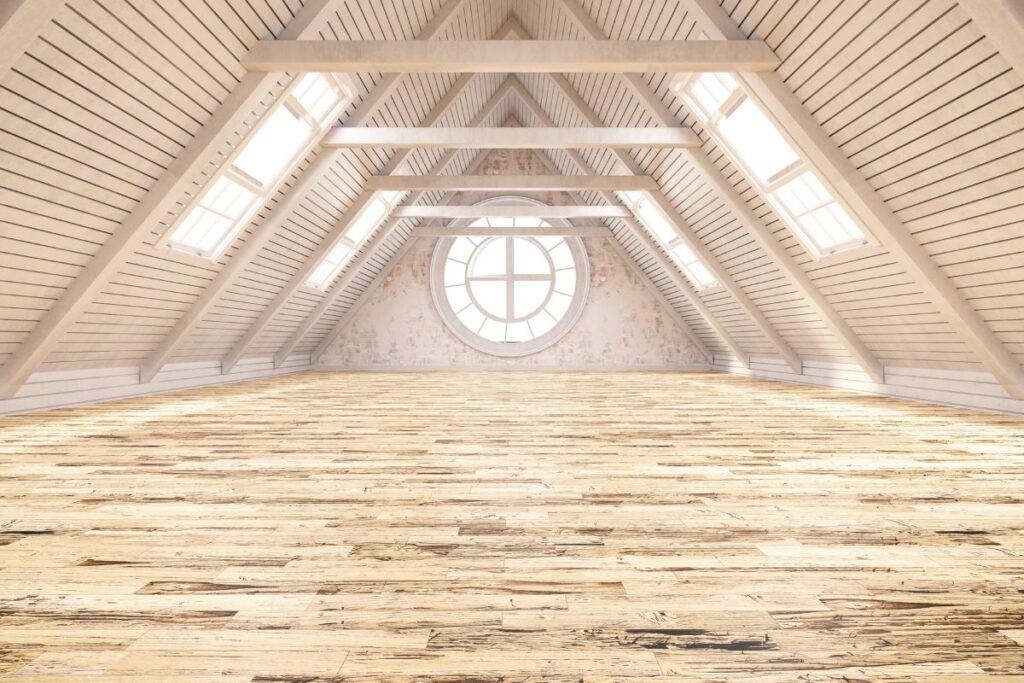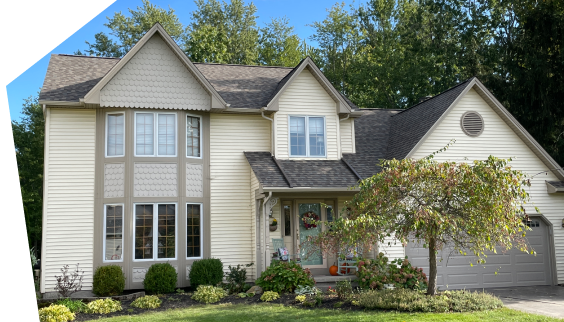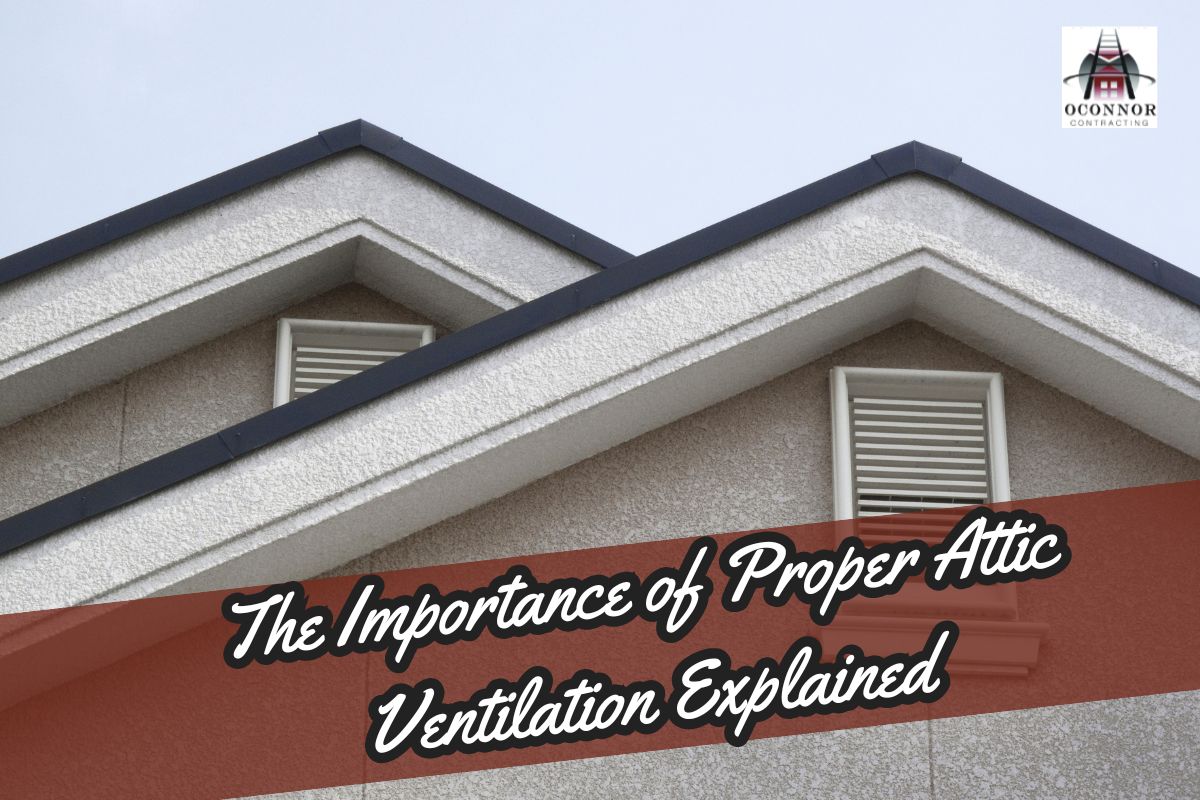As a homeowner, have you ever considered how good airflow in your attic affects your home’s health and energy use? People don’t always think about it, but attic ventilation is important for keeping your house comfy and extends the lifespan of your roof.
Let’s take a closer look at why having good attic ventilation matters and why homeowners should pay attention to it.
What Is Attic Ventilation?
Maintaining ideal conditions in a home’s attic area requires ventilation. It promotes healthy air movement and exchange, preventing problems like excessive heat and moisture buildup.
This balance is achieved by combining intake vents with exhaust vents. This control of airflow helps in temperature regulation and deters condensation. If not done properly, problems like ice dams, higher energy costs, and early roof damage can occur.
For a homeowner, the best attic ventilation not only results in a more energy-efficient house but also averts possible structural problems and encourages a healthier living environment.
How Does Attic Ventilation Work?
Attic ventilation works via a balanced intake and exhaust system. In this setup, intake vents are placed at the soffit or eaves, and exhaust vents are placed at the ridge or upper section of the roof.
Through either the stack effect or wind effect, this configuration promotes natural air circulation within the attic. The stack effect is created when warm air rises and creates variations in pressure that encourage airflow, whereas the wind effect is the outcome of wind-induced pressure changes.
Having optimal airflow requires maintaining a balance between the intake and exhaust vents. The general recommendation for ventilation rate is 1 square foot of inlet area for every 150 square feet of attic space; however, this can change depending on factors like roof size and local climate patterns.
What Is The Importance Of Attic Ventilation?

Now that you know what attic ventilation is, it is also important that you understand how crucial it is for a home:
1. Temperature Regulation
Attic vents facilitate temperature regulation by enabling the escape of excess hot air in summer, thereby preventing heat-related damage such as warping, cracking, and deterioration of roofing components.
Without adequate ventilation, extreme attic temperatures can strain the home’s cooling system, potentially increasing energy consumption and damaging roofing materials.
2. Moisture Control
Effective ventilation in the attic prevents moisture buildup, which can lead to issues like mold growth, wood rot, structural damage, and insulation deterioration.
3. Prevention of Ice Dams
Attic ventilation helps prevent the formation of ice dams, particularly in colder climates, by maintaining uniform temperatures across the roof’s surface. Ice dams can damage roofing components and lead to leaks in the attic.
4. Improved Indoor Air Quality
Proper attic ventilation promotes consistent air exchange, eliminating stale air and introducing fresh air, enhancing indoor air quality.
Insufficient airflow in the attic can accumulate contaminants and pollutants, resulting in degraded indoor air quality over time.
5. Energy Efficiency
Attic vents help to maintain a consistent attic temperature, reducing strain on the home’s heating and cooling systems and ultimately lowering energy costs.
Without proper ventilation, the attic can become an insulating barrier, trapping heat and making the HVAC system work harder, resulting in higher energy bills.
6. Pest Control
Proper ventilation makes the attic less hospitable to pests such as rodents, birds, and insects, as they prefer dark, warm, and humid environments.
Poorly ventilated attics can become breeding grounds for pests, leading to infestations and potential damage to the home’s structure and insulation.
7. Increased Roof Lifespan
Adequate attic ventilation prolongs the roof’s lifespan by preventing heat buildup and moisture accumulation, which can cause premature aging and deterioration of roofing materials.
Inadequate ventilation can accelerate wear and tear on the roof, necessitating more frequent repairs or premature replacement.
Signs Of Poor Attic Ventilation

Now that you understand the importance of sufficient attic ventilation, it is crucial that you keep an eye out for signs of poor attic ventilation, like:
1. Sagging Roof and Discolored Decking:
Inadequate attic ventilation may cause the roof to sag and the roof decking to discolor due to condensation compromising the decking material. This can result in structural issues and a rippled appearance on the roof.
2. Winter Ice Dam Formation:
Another sign of poor ventilation is the formation of ice dams in winter. These dams are caused by improper attic ventilation that causes snow to melt and refreeze at the gutter line.
3. Pest Infestation:
Poor attic ventilation provides a favorable environment for pests. A termite infestation serves as a clear indicator of excess moisture due to ventilation problems.
4. Overheated Upstairs Rooms in Summer:
When the upper rooms in your home become excessively hot during the summer months, it suggests trapped hot air due to inadequate ventilation.
5. Mold Growth and Metal Corrosion:
Excessive moisture from inadequate ventilation can foster mold and mildew growth in the attic, as well as corrosion of metal components such as nails and HVAC ducts.
6. Warping or Buckling Wood:
Wood elements like rafters or trusses in the attic might warp or buckle due to excessive moisture resulting from inadequate ventilation, jeopardizing the roof’s structural integrity.
7. Frost or Condensation Buildup:
The appearance of frost or condensation on the underside of the roof deck during winter indicates insufficient attic ventilation, as warm, moist air from the living space remains trapped.
8. Excessive Energy Bills:
Poor attic ventilation can lead to higher energy bills as the HVAC system exerts more effort to regulate temperature.
9. Musty Odors:
A musty smell within the home could point to inadequate attic ventilation, suggesting the presence of mold or mildew caused by excessive moisture accumulation.
10. Peeling Paint or Wallpaper:
Peeling paint or wallpaper on interior walls may indicate poor attic ventilation, as moisture from the attic can penetrate through and cause damage to the interior surfaces.
How To Calculate Attic Ventilation
Step 1: Determine the Attic Square Footage
For an attic measuring 50 feet in length and 20 feet in width:
Attic Square Footage = Length x Width = 50 x 20 = 1,000 square feet
Step 2: Calculate the Net Free Area (NFA) Required
Following the guideline of 1 square foot of ventilation per 150 square feet of attic space for both intake and exhaust vents:
NFA Required = Attic Square Footage ÷ 300 = 1,000 ÷ 300 = 3.33 square feet
Intake NFA = Exhaust NFA = 3.33 ÷ 2 = 1.67 square feet each
Step 3: Convert Square Feet to Square Inches
Convert square feet to square inches (1 square foot = 144 square inches):
- Intake NFA = 1.67 x 144 = 240.48 square inches
- Exhaust NFA = 1.67 x 144 = 240.48 square inches
Step 4: Select Vents and Calculate the Number Needed
For example, if you are using exhaust roof vents with an NFA of 60 square inches each and vented vinyl soffit with an NFA of 5 square inches per foot:
- Number of Exhaust Vents Needed = 240.48 ÷ 60 = 4 vents
- Length of Vented Vinyl Soffit Needed = 240.48 ÷ 5 = 48.1 feet (round up to 49 feet)
Types of Attic Vents Available
You can choose any type of attic vent as per your attic ventilation requirements:
Types of Attic Exhaust Vents
This type of vent removes hot, moist air from attics and ventilation spaces.
> Box Vents
Box vents are compact fixtures on the roof designed to expel hot air from the attic. They’re suitable for smaller spaces but might necessitate multiple vents for thorough ventilation. Box vents offer a straightforward and economical solution for attic airflow.
> Ridge Vents
Ridge vents run along the roof’s peak, providing continuous ventilation for the attic. They come in two options: without a baffle or with a baffle to prevent debris and pest intrusion. Ridge vents are favored for their consistent airflow and are often recommended for efficient attic ventilation systems.
> Wind Turbines
Wind turbines, or whirly birds, utilize wind and convection to extract hot air from the attic. These active systems can operate even on calm days, promoting airflow through natural convection. Correct installation is vital to prevent issues like water infiltration or pest intrusion.
Types of Attic Intake Vents
These vents allow outside air into attics and ventilation spaces.
> Soffit Vents
Soffit vents, or eave vents, are placed under the roof’s eaves to let cool air into the attic. Working with exhaust vents, they promote airflow and deter moisture buildup. Properly installed soffit vents are crucial for maintaining a well-ventilated and healthy attic.
> Gable Vents
These attic vents are passive fixtures on the gable ends of the attic, facilitating cross-ventilation. Ensuring balance and coordination with other intake and exhaust vents maximizes their effectiveness in attic ventilation.
Conclusion
A healthy and energy-efficient home depends on adequate attic ventilation. You can protect your property and improve indoor comfort by realizing its importance and acting proactively. To get years of worry-free attic ventilation, rely on OConnor Contracting for professional roofing services. Get in touch with us at (716) 600-7663 to improve the comfort and functionality of your home.


